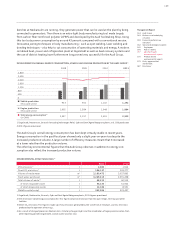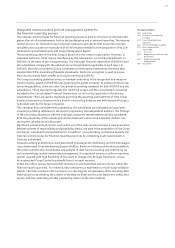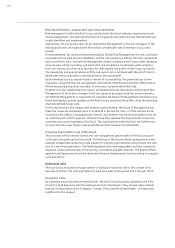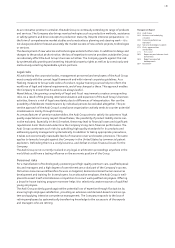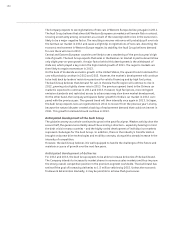Audi 2011 Annual Report Download - page 182
Download and view the complete annual report
Please find page 182 of the 2011 Audi annual report below. You can navigate through the pages in the report by either clicking on the pages listed below, or by using the keyword search tool below to find specific information within the annual report.
179
Management Report
134 Audi Group
143 Business and underlying
situation
159 Financial performance
indicators
162 Social and ecological aspects
175 Risks, opportunities
and outlook
175 Risk report
183 Report on post-balance sheet
date events
183 Report on expected
developments
187 Disclaimer
The upturn in the global economy continued in the past fiscal year, although the upswing lost
momentum in the second half, especially in Western Europe. Global demand for cars benefited
from the positive economic trend and reached a new record level in 2011. While Japan and a
number of Western European markets reported lower levels of new registrations, demand for
automobiles particularly in China, Russia and the United States was a key driver of global market
growth.
In particular the emerging Asian and Latin American car markets are likely to continue posting
high growth rates in the next few years, whereas a downturn in demand for passenger cars is
expected in Western Europe in 2012. However, new risks could fundamentally arise as a result of
changing framework conditions, such as increased customs, tax and trade barriers.
Extensive risk early-warning indicators are used and the market is continually monitored so as to
plan production in accordance with demand and also adjust it at short notice to fluctuations in
demand. The ability to transfer production between the various locations under the production
turntable principle and the effective use of timebanking also bring increased flexibility.
The continual monitoring of all relevant commodity markets is an important activity for the Audi
Group, because this helps to secure adequate supplies of production materials while simulta-
neously minimizing the cost risks and paving the way for comprehensive hedging strategies.
Oil price movements present a further risk for a carmaker such as the Audi Group. A permanent
rise in the price not only leads to increased energy and production costs, but also pushes up fuel
prices and therefore ultimately makes customers more reluctant to buy cars. The Audi Group
aims to respond to growing calls for efficiency by swiftly developing and introducing fuel economy
technologies for conventional combustion engines. For example, the Audi brand already has a
comprehensive product range featuring high-efficiency, progressive vehicle concepts that use
technologies from the modular efficiency platform. Meanwhile, alternative forms of drive such
as hybrid and electric vehicles are a central component of the Company’s strategy of diversified
drive principles.
The continuing internationalization of the Audi Group is resulting in increased revenue denomi-
nated in foreign currency. The growing volatility of currency markets, exacerbated in particular
by sovereign debt crises in various countries, is creating risks that are difficult to anticipate and
could adversely affect the profit performance of the Audi Group. Movements in the U.S. dollar,
the Japanese yen, the pound sterling and the Chinese renminbi against the euro are of particular
significance for the Audi Group. To counter the potential risks, the Company employs appropriate
hedging instruments to an economically reasonable extent and in close, continuous consultation
with the Volkswagen Group.
Finally, events that cannot be anticipated such as political intervention in the economy, terror
attacks, escalating political conflicts, natural disasters and emerging pandemics can adversely
affect economic activity and the international financial and capital markets. These could also
have a detrimental effect on the Audi Group’s business performance. The Company restricts such
risks by preparing emergency plans or, where appropriate, by taking out adequate insurance
cover.
Industry risks
The increasingly volatile and varied development of car markets worldwide, rising technological
demands and ever tougher efficiency requirements are creating a more demanding environment
for the entire automotive industry.


